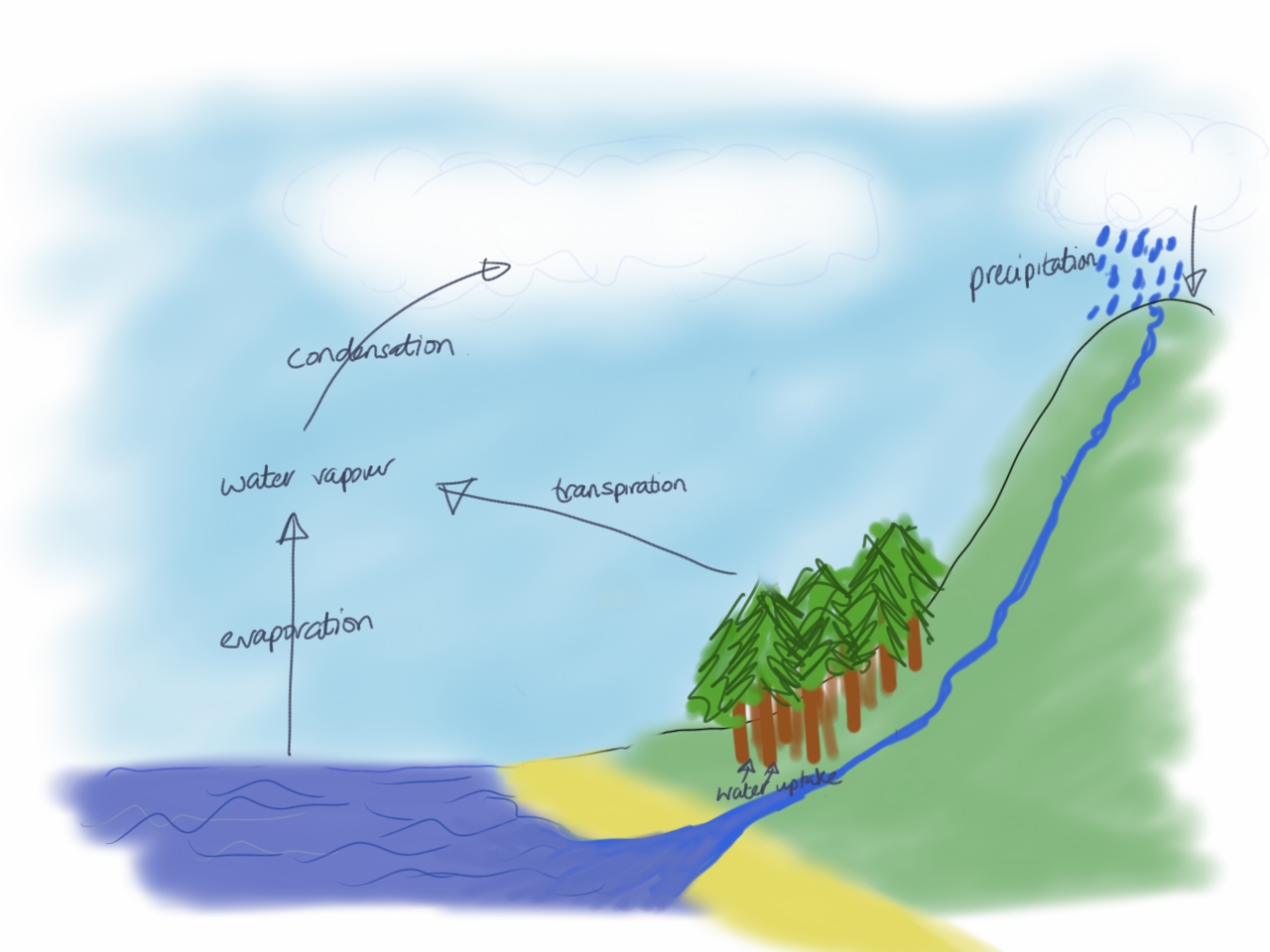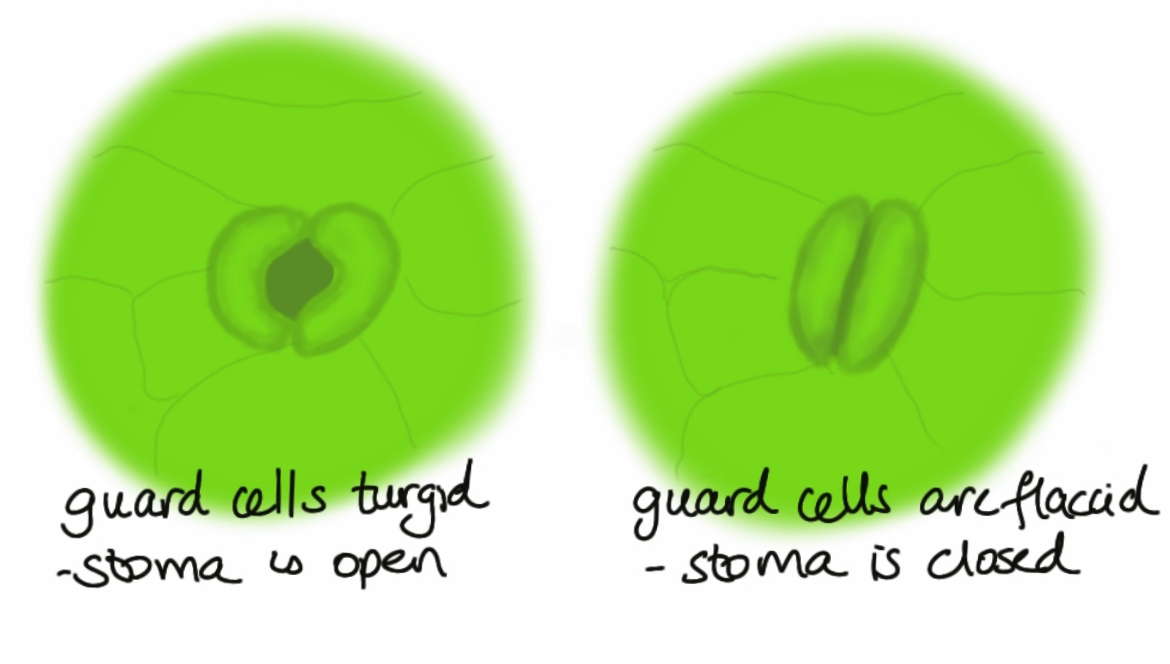Short version:
These three processes are connected by water. Plants need water for photosynthesis. Water is a waste product of respiration. Transpiration is a necessary movement of water to supply photosynthesis, keep the plant cool, move mineral ions and keep the plant’s shape.
Photosynthesis

Chlorophyll is a green pigment that absorbs the light energy required for photosynthesis to occur. Therefore, any green part can photosynthesise but it happens mainly in the leaves. They have a large surface area and take in carbon dioxide through pores in the underside of the leaf called stomata (singular stoma). Water is absorbed by the roots and then transported to the leaves via vessels called xylem.
Glucose (the simple sugar that is synthesised) is then transported to all over the plant where it is needed via other vessels called phloem. Glucose can be used in respiration to provide cells with energy, or converted into starch for storage or into other organic molecules like cellulose, lipids (fats and oils) and proteins (though proteins will also need nitrogen from nitrates).
So, the requirements for photosynthesis and therefore the creating of glucose needed for growth and respiration depends on the availability of carbon dioxide, water and light.
Respiration
This is something that every living thing does in every single cell. It isn’t breathing. Plants can’t breathe. They have no lungs. What they do is respire, converting glucose into carbon dioxide and water with a release of energy. Creatures that do breathe do so to take in oxygen and give out carbon dioxide.

This is why you shouldn’t keep plants in your bedroom at night. Like the husband, they will compete with you for oxygen. Respiration will happen constantly, but during the day the rate of photosynthesis out strips the rate of respiration, so it seems like the plant is just producing oxygen.
This energy produced is used to convert the glucose to other organic molecules and to take up mineral ions through roots. The concentration of minerals inside the plants are often higher than outside so energy is required to move against the concentration gradient. This would be like having a sink full of water with food colouring in it, putting a colander in the water and wanting the food colouring to accumulate in the colander. It’s not something that happens of its own accord.
Transpiration

If you’ve ever seen a water cycle you will know that water vapour in the air increases through evaporation and through transpiration. Water is evaporated from the leaves of all plants. The movement of water through the plant is called the transpiration stream, which is important for:
- Supplying the leaves with water for photosynthesis
- Carrying minerals ions dissolved in the water (this would be how the plant gets nitrogen in the form of nitrates to make proteins or how the plant gets magnesium which is a component of chlorophyll).
- Like sweating for us, water evaporates from the leaves, cooling the plant
- Water is required to keep cells of the plant turgid, which is when a plant cell is ‘full’ of water. When the cells are not turgid the plant loses structure. This would be why your basil goes floppy when it’s lacking in water, but goes all rigid again after you’ve given it a drink.
The water, absorbed by the roots, carried by the xylem will evaporate out of the stomata. The stomata are opened and closed by banana shaped cells called guard cells. When the guard cells are turgid, the stomata open. They lose turgidity with lack of water or in the dark. A plant cannot photosynthesise without water or without light so the stomata should close to avoid loss of water through transpiration.

In summer when the sun shines the brightest and the weather is warmest photosynthesis happens at a quick rate and therefore so does growth. This means that the limiting factor will be water. So, water, or the lack of it, will control how fast your plants grow. It’s like having a load of baking ingredients and wanting to bake as many cakes as possible. If you only have 2 eggs and each cake needs 2 eggs then the number of eggs you have limit how many cakes you can bake. If you then buy a tray of 30 eggs you’ll find that there’ll be another ingredient that will limit how many cakes you can make. Similarly, once the plant has enough water to ‘keep up’ with the sunlight provided, adding more water won’t increase growth. Maybe something like amount of chlorophyll becomes the limiting factor.
Also in summer, plants will transpire more in order to stay cool and just by having the stomata open for photosynthesis there will be loss of water out of these pores.
When those heatwaves hit you need to make sure your plants have a suitable source of water not just to avoid plant-acide to also to take advantage of the supply of sunlight to give lots of fantastic growth.
3 thoughts on “Photosynthesis, Respiration and Transpiration”